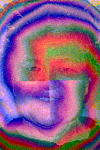
Time Spin: Fast Intermittent Sequence
Northeast New Jersey parks, New Jersey, USA
June 21, 2009, 10:00
Moving the camera streaked the images across the frames. Speed excites. What the image shows is faster than spinning the panorama. The camera frames were interlaced, painting fields alternately.
Each image in a movie or part of a panorama is an increment and as such, represents an intermittent happening. In stitching a panorama, we attempt to blend together separate moments (or parts of space at separate moments), but in fact they are not continuous.
The camera catches a dog in mid-air. She's after bubbles. Imagine the sequence of events: water spills and spreads as the dog turns, leaps, and charges, trying to reach what can't be stopped: time.
Lat: 40° 44' 22.9" N
Long: 75° 18' 24.18" W
Elevation: 165 m
Precision is: High. Pinpoints the exact spot.
When there was too much contrast between dark and light areas, such as the interior of a garage vs. the sunny driveway, the camera blurred and could not read the light and adjust to the changes fast enough. The evenly-lit landscape worked best.
When I lost my footing or was distracted, the spin was irregular and the sequence of images didn't match. A solid flat regular concrete base worked best.
At 30 frames per second, I had about 56 frames to work with. In QuickTime Pro I exported them to TIFF images. In Authoring Studio I cut out approximately 4 images between each selected frame that would have about 1/4 of the image overlap with the previous one. I ended up with 11 images to stitch.
The dog and bubbles came from another movie. In Photoshop, I superimposed them. Then remade the QuickTime panorama in Authoring Studio.
I exported the equirectangular JPEG as a web image at 100% quality. It was only about 3000 pixels long, limited by the resolution of the exported video frame sources.



 Tap or click the zoom icon in the bottom right corner of the picture to switch between in-page and fullscreen view
Tap or click the zoom icon in the bottom right corner of the picture to switch between in-page and fullscreen view